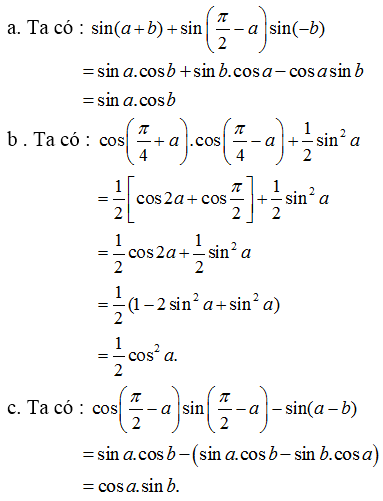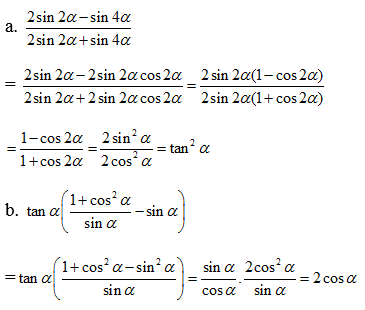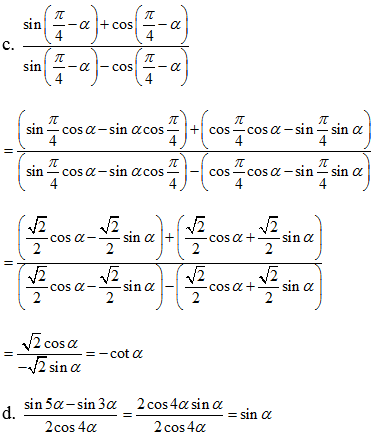Hãy nhập câu hỏi của bạn vào đây, nếu là tài khoản VIP, bạn sẽ được ưu tiên trả lời.

Câu a)
Ta sử dụng 2 công thức:
\(\bullet \tan (180-\alpha)=-\tan \alpha\)
\(\bullet \tan (\alpha+\beta)=\frac{\tan \alpha+\tan \beta}{1-\tan \alpha.\tan \beta}\)
Áp dụng vào bài toán:
\(\text{VT}=\tan A+\tan B+\tan C=\tan A+\tan B+\tan (180-A-B)\)
\(=\tan A+\tan B-\tan (A+B)=\tan A+\tan B-\frac{\tan A+\tan B}{1-\tan A.\tan B}\)
\(=(\tan A+\tan B)\left(1+\frac{1}{1-\tan A.\tan B}\right)=(\tan A+\tan B).\frac{-\tan A.\tan B}{1-\tan A.\tan B}\)
\(=-\tan A.\tan B.\frac{\tan A+\tan B}{1-\tan A.\tan B}=-\tan A.\tan B.\tan (A+B)\)
\(=\tan A.\tan B.\tan (180-A-B)\)
\(=\tan A.\tan B.\tan C=\text{VP}\)
Do đó ta có đpcm
Tam giác $ABC$ có ba góc nhọn nên \(\tan A, \tan B, \tan C>0\)
Áp dụng BĐT Cauchy ta có:
\(P=\tan A+\tan B+\tan C\geq 3\sqrt[3]{\tan A.\tan B.\tan C}\)
\(\Leftrightarrow P=\tan A+\tan B+\tan C\geq 3\sqrt[3]{\tan A+\tan B+\tan C}\)
\(\Rightarrow P\geq 3\sqrt[3]{P}\)
\(\Rightarrow P^3\geq 27P\Leftrightarrow P(P^2-27)\geq 0\)
\(\Rightarrow P^2-27\geq 0\Rightarrow P\geq 3\sqrt{3}\)
Vậy \(P_{\min}=3\sqrt{3}\). Dấu bằng xảy ra khi \(\angle A=\angle B=\angle C=60^0\)
Câu b)
Ta sử dụng 2 công thức chính:
\(\bullet \tan (\alpha+\beta)=\frac{\tan \alpha+\tan \beta}{1-\tan \alpha.\tan \beta}\)
\(\bullet \tan (90-\alpha)=\frac{1}{\tan \alpha}\)
Áp dụng vào bài toán:
\(\text{VT}=\tan \frac{A}{2}.\tan \frac{B}{2}+\tan \frac{B}{2}.\tan \frac{C}{2}+\tan \frac{C}{2}.\tan \frac{A}{2}\)
\(=\tan \frac{A}{2}.\tan \frac{B}{2}+\tan \frac{C}{2}(\tan \frac{A}{2}+\tan \frac{B}{2})\)
\(=\tan \frac{A}{2}.\tan \frac{B}{2}+\tan (90-\frac{A+B}{2})(\tan \frac{A}{2}+\tan \frac{B}{2})\)
\(=\tan \frac{A}{2}.\tan \frac{B}{2}+\frac{\tan \frac{A}{2}+\tan \frac{B}{2}}{\tan (\frac{A+B}{2})}\)
\(=\tan \frac{A}{2}.\tan \frac{B}{2}+\frac{\tan \frac{A}{2}+\tan \frac{B}{2}}{\frac{\tan \frac{A}{2}+\tan \frac{B}{2}}{1-\tan \frac{A}{2}.\tan \frac{B}{2}}}\)
\(=\tan \frac{A}{2}.\tan \frac{B}{2}+1-\tan \frac{A}{2}.\tan \frac{B}{2}=1=\text{VP}\)
Ta có đpcm.
Cũng giống phần a, ta biết do ABC là tam giác nhọn nên
\(\tan A, \tan B, \tan C>0\)
Đặt \(\tan A=x, \tan B=y, \tan C=z\). Ta có: \(xy+yz+xz=1\)
Và \(T=x+y+z\)
\(\Rightarrow T^2=x^2+y^2+z^2+2(xy+yz+xz)\)
Theo hệ quả quen thuộc của BĐT Cauchy:
\(x^2+y^2+z^2\geq xy+yz+xz\)
\(\Rightarrow T^2\geq 3(xy+yz+xz)=3\)
\(\Rightarrow T\geq \sqrt{3}\Leftrightarrow T_{\min}=\sqrt{3}\)
Dấu bằng xảy ra khi \(x=y=z=\frac{1}{\sqrt{3}}\Leftrightarrow \angle A=\angle B=\angle C=60^0\)

Bài 1:
a)
\(\sin ^2x+\sin ^2x\cot^2x=\sin ^2x(1+\cot^2x)=\sin ^2x(1+\frac{\cos ^2x}{\sin ^2x})\)
\(=\sin ^2x.\frac{\sin ^2x+\cos^2x}{\sin ^2x}=\sin ^2x+\cos^2x=1\)
b)
\((1-\tan ^2x)\cot^2x+1-\cot^2x\)
\(=\cot^2x(1-\tan^2x-1)+1=\cot^2x(-\tan ^2x)+1=-(\tan x\cot x)^2+1\)
\(=-1^2+1=0\)
c)
\(\sin ^2x\tan x+\cos^2x\cot x+2\sin x\cos x=\sin ^2x.\frac{\sin x}{\cos x}+\cos ^2x.\frac{\cos x}{\sin x}+2\sin x\cos x\)
\(=\frac{\sin ^3x}{\cos x}+\frac{\cos ^3x}{\sin x}+2\sin x\cos x=\frac{\sin ^4x+\cos ^4x+2\sin ^2x\cos ^2x}{\sin x\cos x}=\frac{(\sin ^2x+\cos ^2x)^2}{\sin x\cos x}=\frac{1}{\sin x\cos x}\)
\(=\frac{1}{\frac{\sin 2x}{2}}=\frac{2}{\sin 2x}\)
Bài 2:
Áp dụng BĐT Cauchy Schwarz ta có:
\(P=\frac{a^2}{\sqrt{a(2c+a+b)}}+\frac{b^2}{\sqrt{b(2a+b+c)}}+\frac{c^2}{\sqrt{c(2b+c+a)}}\)
\(\geq \frac{(a+b+c)^2}{\sqrt{a(2c+a+b)}+\sqrt{b(2a+b+c)}+\sqrt{c(2b+c+a)}}(*)\)
Tiếp tục áp dụng BĐT Cauchy-Schwarz:
\((\sqrt{a(2c+a+b)}+\sqrt{b(2a+b+c)}+\sqrt{c(2b+c+a)})^2\leq (a+b+c)(2c+a+b+2a+b+c+2b+c+a)\)
\(\Leftrightarrow (\sqrt{a(2c+a+b)}+\sqrt{b(2a+b+c)}+\sqrt{c(2b+c+a)})^2\leq 4(a+b+c)^2\)
\(\Rightarrow \sqrt{a(2c+a+b)}+\sqrt{b(2a+b+c)}+\sqrt{c(2b+c+a)}\leq 2(a+b+c)(**)\)
Từ \((*); (**)\Rightarrow P\geq \frac{(a+b+c)^2}{2(a+b+c)}=\frac{a+b+c}{2}=\frac{3}{2}\)
Vậy \(P_{\min}=\frac{3}{2}\)
Dấu "=" xảy ra khi $a=b=c=1$

Lời giải:
a)
\(\frac{\cos (a-b)}{\cos (a+b)}=\frac{\cos a\cos b+\sin a\sin b}{\cos a\cos b-\sin a\sin b}=\frac{\frac{\cos a\cos b}{\sin a\sin b}+1}{\frac{\cos a\cos b}{\sin a\sin b}-1}=\frac{\cot a\cot b+1}{\cot a\cot b-1}\)
b)
\(2(\sin ^6a+\cos ^6a)+1=2(\sin ^2a+\cos ^2a)(\sin ^4a-\sin ^2a\cos ^2a+\cos ^4a)+1\)
\(=2(\sin ^4a-\sin ^2a\cos ^2a+\cos ^4a)+1\)
\(=3(\sin ^4a+\cos ^4a)-(\sin ^4a+\cos ^4a+2\sin ^2a\cos ^2a)+1\)
\(=3(\sin ^4a+\cos ^4a)-(\sin ^2a+\cos ^2a)^2+1\)
\(=3(\sin ^4a+\cos ^4a)-1^2+1=3(\sin ^4a+\cos ^4a)\)
c)
\(\frac{\tan a-\tan b}{cot b-\cot a}=\frac{\tan a-\tan b}{\frac{1}{\tan b}-\frac{1}{\tan a}}\) (nhớ rằng \(\tan x.\cot x=1\rightarrow \cot x=\frac{1}{\tan x}\) )
\(=\frac{\tan a-\tan b}{\frac{\tan a-\tan b}{\tan a\tan b}}=\tan a\tan b\)
d)
\((\cot x+\tan x)^2-(\cot x-\tan x)^2=(\cot ^2x+\tan ^2x+2\cot x\tan x)-(\cot ^2x-2\cot x\tan x+\tan ^2x)\)
\(=4\cot x\tan x=4.1=4\)
e)
\(\frac{\sin ^3a+\cos ^3a}{\sin a+\cos a}=\frac{(\sin a+\cos a)(\sin ^2a-\sin a\cos a+\cos ^2a)}{\sin a+\cos a}\)
\(=\sin ^2a-\sin a\cos a+\cos ^2a=(\sin ^2a+\cos ^2a)-\sin a\cos a=1-\sin a\cos a\)
Vậy ta có đpcm.

rút gọn biểu thức:
E=cos(\(\dfrac{3\pi}{3}-\alpha\))-sin(\(\dfrac{3\pi}{2}-\alpha\))+sin(\(\alpha+4\pi\))

a) \(A=sin\left(\dfrac{\pi}{4}+x\right)-cos\left(\dfrac{\pi}{4}-x\right)\)
\(\Leftrightarrow A=sin\dfrac{\pi}{4}.cosx+cos\dfrac{\pi}{4}.sinx-\left(cos\dfrac{\pi}{4}.cosx+sin\dfrac{\pi}{4}.sinx\right)\)
\(\Leftrightarrow A=sin\dfrac{\pi}{4}.cosx+cos\dfrac{\pi}{4}.sinx-cos\dfrac{\pi}{4}.cosx-sin\dfrac{\pi}{4}.sinx\)
\(\Leftrightarrow A=\dfrac{\sqrt{2}}{2}.cosx+\dfrac{\sqrt{2}}{2}.sinx-\dfrac{\sqrt{2}}{2}.cosx-\dfrac{\sqrt{2}}{2}.sinx\)
\(\Leftrightarrow A=0\)
b) \(B=cos\left(\dfrac{\pi}{6}-x\right)-sin\left(\dfrac{\pi}{3}+x\right)\)
\(\Leftrightarrow B=cos\dfrac{\pi}{6}.cosx+sin\dfrac{\pi}{6}.sinx-\left(sin\dfrac{\pi}{3}.cosx+cos\dfrac{\pi}{3}.sinx\right)\)
\(\Leftrightarrow B=cos\dfrac{\pi}{6}.cosx+sin\dfrac{\pi}{6}.sinx-sin\dfrac{\pi}{3}.cosx-cos\dfrac{\pi}{3}.sinx\)
\(\Leftrightarrow B=\dfrac{\sqrt{3}}{2}.cosx+\dfrac{1}{2}.sinx-\dfrac{\sqrt{3}}{2}.cosx-\dfrac{1}{2}.sinx\)
\(\Leftrightarrow B=0\)
c) \(C=sin^2x+cos\left(\dfrac{\pi}{3}-x\right).cos\left(\dfrac{\pi}{3}+x\right)\)
\(\Leftrightarrow C=sin^2x+\left(cos\dfrac{\pi}{3}.cosx+sin\dfrac{\pi}{3}.sinx\right).\left(cos\dfrac{\pi}{3}.cosx-sin\dfrac{\pi}{3}.sinx\right)\)
\(\Leftrightarrow C=sin^2x+\left(\dfrac{1}{2}.cosx+\dfrac{\sqrt{3}}{2}.sinx\right).\left(\dfrac{1}{2}.cosx-\dfrac{\sqrt{3}}{2}.sinx\right)\)
\(\Leftrightarrow C=sin^2x+\dfrac{1}{4}.cos^2x-\dfrac{3}{4}.sin^2x\)
\(\Leftrightarrow C=\dfrac{1}{4}.sin^2x+\dfrac{1}{4}.cos^2x\)
\(\Leftrightarrow C=\dfrac{1}{4}\left(sin^2x+cos^2x\right)\)
\(\Leftrightarrow C=\dfrac{1}{4}\)
d) \(D=\dfrac{1-cos2x+sin2x}{1+cos2x+sin2x}.cotx\)
\(\Leftrightarrow D=\dfrac{1-\left(1-2sin^2x\right)+2sinx.cosx}{1+2cos^2a-1+2sinx.cosx}.cotx\)
\(\Leftrightarrow D=\dfrac{2sin^2x+2sinx.cosx}{2cos^2x+2sinx.cosx}.cotx\)
\(\Leftrightarrow D=\dfrac{2sinx\left(sinx+cosx\right)}{2cosx\left(cosx+sinx\right)}.cotx\)
\(\Leftrightarrow D=\dfrac{sinx}{cosx}.cotx\)
\(\Leftrightarrow D=tanx.cotx\)
\(\Leftrightarrow D=1\)

Do \(\pi< \alpha< \dfrac{3\pi}{2}\) nên \(sin\alpha,cos\alpha< 0;tan\alpha,cot\alpha< 0\).
\(cos\left(\alpha-\dfrac{\pi}{2}\right)=cos\left(\dfrac{\pi}{2}-\alpha\right)=sin\alpha< 0\).
\(sin\left(\dfrac{\pi}{2}+\alpha\right)=cos\alpha< 0\).
\(tan\left(\dfrac{3\pi}{2}-\alpha\right)=tan\left(\dfrac{3\pi}{2}-\alpha-2\pi\right)\)\(=tan\left(-\dfrac{\pi}{2}-\alpha\right)\)\(=-tan\left(\dfrac{\pi}{2}+\alpha\right)=cot\left(\alpha\right)>0\).
\(cot\left(\alpha+\pi\right)=cot\left(\alpha\right)>0\).




\(1=tan\left(\dfrac{\pi}{4}\right)=tan\left(a+b\right)=\dfrac{tana+tanb}{1-tana.tanb}\)
\(\Rightarrow tana+tanb=1-tana.tanb\)
\(\Rightarrow tana+tanb+tana.tanb=1\)
Do đó:
\(M=1+tana+tanb+tana.tanb=1+1=2\)